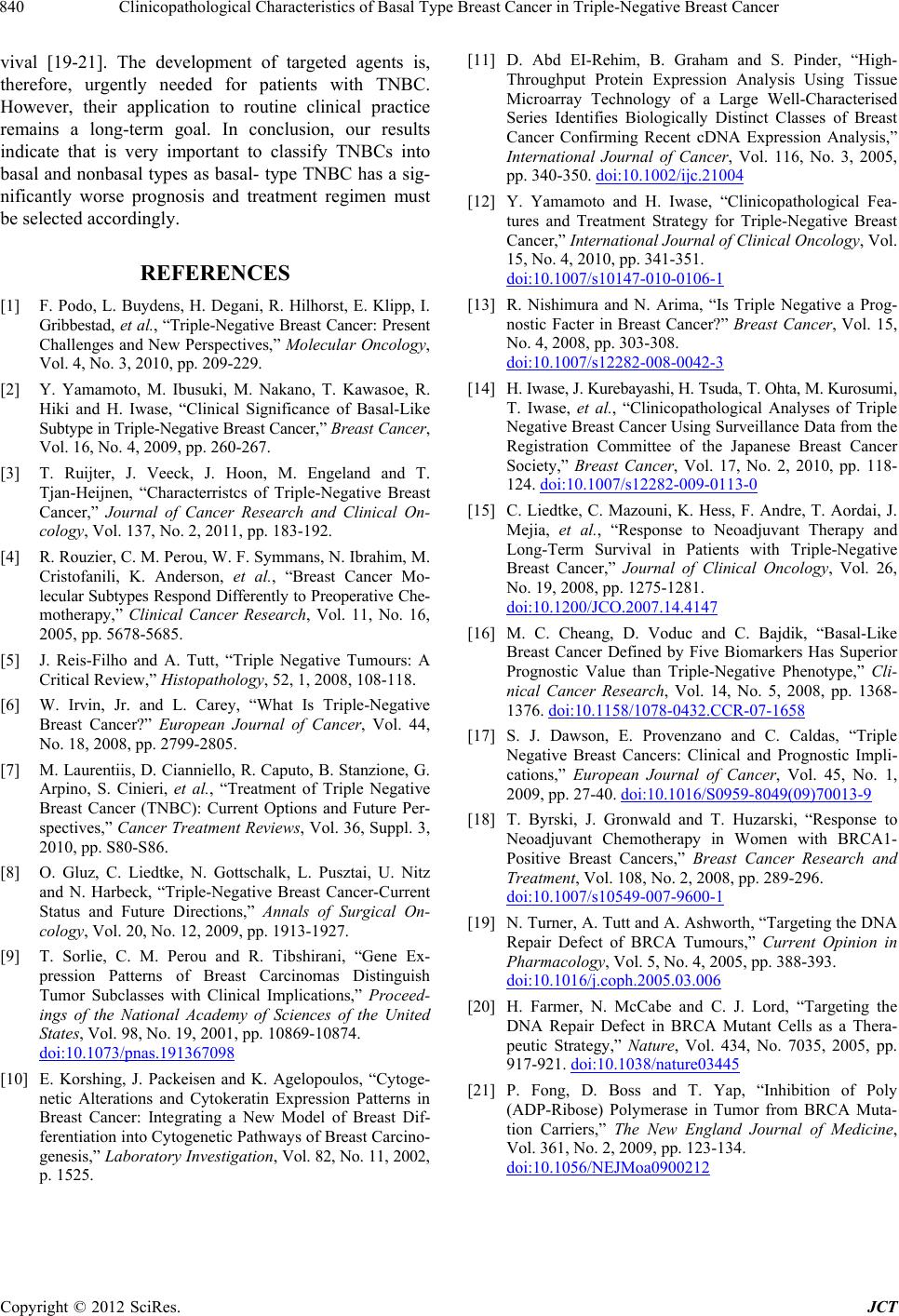
Clinicopathological Characteristics of Basal Type Breast Cancer in Triple-Negative Breast Cancer
Copyright © 2012 SciRes. JCT
840
vival [19-21]. The development of targeted agents is,
therefore, urgently needed for patients with TNBC.
However, their application to routine clinical practice
remains a long-term goal. In conclusion, our results
indicate that is very important to classify TNBCs into
basal and nonbasal types as basal- type TNBC has a sig-
nificantly worse prognosis and treatment regimen must
be selected accordingly.
REFERENCES
[1] F. Podo, L. Buydens, H. Degani, R. Hilhorst, E. Klipp, I.
Gribbestad, et al., “Triple-Negative Breast Cancer: Present
Challenges and New Perspectives,” Molecular Oncology,
Vol. 4, No. 3, 2010, pp. 209-229.
[2] Y. Yamamoto, M. Ibusuki, M. Nakano, T. Kawasoe, R.
Hiki and H. Iwase, “Clinical Significance of Basal-Like
Subtype in Triple-Negative Brea st Cancer,” Breast Cance r,
Vol. 16, No. 4, 2009, pp. 260-267.
[3] T. Ruijter, J. Veeck, J. Hoon, M. Engeland and T.
Tjan-Heijnen, “Characterristcs of Triple-Negative Breast
Cancer,” Journal of Cancer Research and Clinical On-
cology, Vol. 137, No. 2, 2011, pp. 183-192.
[4] R. Rouzier, C. M. Perou, W. F. Symmans, N. Ibrahi m, M.
Cristofanili, K. Anderson, et al., “Breast Cancer Mo-
lecular Subtypes Respond Differently to Preoperative Che-
motherapy,” Clinical Cancer Research, Vol. 11, No. 16,
2005, pp. 5678-5685.
[5] J. Reis-Filho and A. Tutt, “Triple Negative Tumours: A
Critical Review,” Histopathology, 52, 1, 2008, 108-118.
[6] W. Irvin, Jr. and L. Carey, “What Is Triple-Negative
Breast Cancer?” European Journal of Cancer, Vol. 44,
No. 18, 2008, pp. 2799-2805.
[7] M. Laurentiis, D. Cianniello, R. Caputo, B. Stanzione, G.
Arpino, S. Cinieri, et al., “Treatment of Triple Negative
Breast Cancer (TNBC): Current Options and Future Per-
spectives,” Cancer Treatment Reviews, Vol. 36, Suppl. 3,
2010, pp. S80-S86.
[8] O. Gluz, C. Liedtke, N. Gottschalk, L. Pusztai, U. Nitz
and N. Harbeck, “Triple-Negative Breast Cancer-Current
Status and Future Directions,” Annals of Surgical On-
cology, Vol. 20, No. 12, 2009, pp. 1913-1927.
[9] T. Sorlie, C. M. Perou and R. Tibshirani, “Gene Ex-
pression Patterns of Breast Carcinomas Distinguish
Tumor Subclasses with Clinical Implications,” Proceed-
ings of the National Academy of Sciences of the United
States, Vol. 98, No. 19, 2001, pp. 10869-10874.
doi:10.1073/pnas.191367098
[10] E. Korshing, J. Packeisen and K. Agelopoulos, “Cytoge-
netic Alterations and Cytokeratin Expression Patterns in
Breast Cancer: Integrating a New Model of Breast Dif-
ferentiation into Cytogenetic Pathways of Breast Carcino-
genesis,” Laboratory Investigation, Vol. 82, No. 11, 2002,
p. 1525.
[11] D. Abd EI-Rehim, B. Graham and S. Pinder, “High-
Throughput Protein Expression Analysis Using Tissue
Microarray Technology of a Large Well-Characterised
Series Identifies Biologically Distinct Classes of Breast
Cancer Confirming Recent cDNA Expression Analysis,”
International Journal of Cancer, Vol. 116, No. 3, 2005,
pp. 340-350. doi:10.1002/ijc.21004
[12] Y. Yamamoto and H. Iwase, “Clinicopathological Fea-
tures and Treatment Strategy for Triple-Negative Breast
Cancer,” International Journal of Clinical Oncology, Vol.
15, No. 4, 2010, pp. 341-351.
doi:10.1007/s10147-010-0106-1
[13] R. Nishimura and N. Arima, “Is Triple Negative a Prog-
nostic Facter in Breast Cancer?” Breast Cancer, Vol. 15,
No. 4, 2008, pp. 303-308.
doi:10.1007/s12282-008-0042-3
[14] H. Iwase, J. Kurebayashi, H. Tsuda, T. Ohta, M. Kurosumi,
T. Iwase, et al., “Clinicopathological Analyses of Triple
Negative Breast Cancer Using Surveillance Data from the
Registration Committee of the Japanese Breast Cancer
Society,” Breast Cancer, Vol. 17, No. 2, 2010, pp. 118-
124. doi:10.1007/s12282-009-0113-0
[15] C. Liedtke, C. Mazouni, K. Hess, F. Andre, T. Aordai, J.
Mejia, et al., “Response to Neoadjuvant Therapy and
Long-Term Survival in Patients with Triple-Negative
Breast Cancer,” Journal of Clinical Oncology, Vol. 26,
No. 19, 2008, pp. 1275-1281.
doi:10.1200/JCO.2007.14.4147
[16] M. C. Cheang, D. Voduc and C. Bajdik, “Basal-Like
Breast Cancer Defined by Five Biomarkers Has Superior
Prognostic Value than Triple-Negative Phenotype,” Cli-
nical Cancer Research, Vol. 14, No. 5, 2008, pp. 1368-
1376. doi:10.1158/1078-0432.CCR-07-1658
[17] S. J. Dawson, E. Provenzano and C. Caldas, “Triple
Negative Breast Cancers: Clinical and Prognostic Impli-
cations,” European Journal of Cancer, Vol. 45, No. 1,
2009, pp. 27-40. doi:10.1016/S0959-8049(09)70013-9
[18] T. Byrski, J. Gronwald and T. Huzarski, “Response to
Neoadjuvant Chemotherapy in Women with BRCA1-
Positive Breast Cancers,” Breast Cancer Research and
Treatment, Vol. 108, No. 2, 2008, pp. 289-296.
doi:10.1007/s10549-007-9600-1
[19] N. Turner, A. Tutt and A. Ashworth, “Targeting the DNA
Repair Defect of BRCA Tumours,” Current Opinion in
Pharmacology, Vol. 5, No. 4, 2005, pp. 388-393.
doi:10.1016/j.coph.2005.03.006
[20] H. Farmer, N. McCabe and C. J. Lord, “Targeting the
DNA Repair Defect in BRCA Mutant Cells as a Thera-
peutic Strategy,” Nature, Vol. 434, No. 7035, 2005, pp.
917-921. doi:10.1038/nature03445
[21] P. Fong, D. Boss and T. Yap, “Inhibition of Poly
(ADP-Ribose) Polymerase in Tumor from BRCA Muta-
tion Carriers,” The New England Journal of Medicine,
Vol. 361, No. 2, 2009, pp. 123-134.
doi:10.1056/NEJMoa0900212